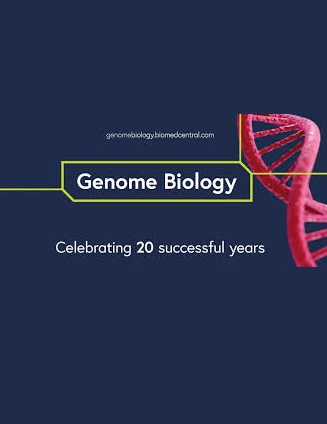Endometrial tumorigenesis involves epigenetic plasticity demarcating non-coding somatic mutations and 3D-genome alterations
IF 10.1
1区 生物学
Q1 BIOTECHNOLOGY & APPLIED MICROBIOLOGY
引用次数: 0
Abstract
The incidence and mortality of endometrial cancer (EC) is on the rise. Eighty-five percent of ECs depend on estrogen receptor alpha (ERα) for proliferation, but little is known about its transcriptional regulation in these tumors. We generate epigenomics, transcriptomics, and Hi-C datastreams in healthy and tumor endometrial tissues, identifying robust ERα reprogramming and profound alterations in 3D genome organization that lead to a gain of tumor-specific enhancer activity during EC development. Integration with endometrial cancer risk single-nucleotide polymorphisms and whole-genome sequencing data from primary tumors and metastatic samples reveals a striking enrichment of risk variants and non-coding somatic mutations at tumor-enriched ERα sites. Through machine learning-based predictions and interaction proteomics analyses, we identify an enhancer mutation which alters 3D genome conformation, impairing recruitment of the transcriptional repressor EHMT2/G9a/KMT1C, thereby alleviating transcriptional repression of ESR1 in EC. In summary, we identify a complex genomic-epigenomic interplay in EC development and progression, altering 3D genome organization to enhance expression of the critical driver ERα.子宫内膜肿瘤发生涉及区分非编码体细胞突变和3d基因组改变的表观遗传可塑性
子宫内膜癌(EC)的发病率和死亡率呈上升趋势。85%的内皮细胞依赖雌激素受体α (ERα)增殖,但对其在这些肿瘤中的转录调控知之甚少。我们在健康和肿瘤子宫内膜组织中生成了表观基因组学、转录组学和high - c数据流,确定了在EC发展过程中导致肿瘤特异性增强子活性增加的强大的ERα重编程和3D基因组组织的深刻改变。结合来自原发性肿瘤和转移性样本的子宫内膜癌风险单核苷酸多态性和全基因组测序数据,揭示了肿瘤富集的ERα位点的风险变异和非编码体细胞突变的显著富集。通过基于机器学习的预测和相互作用蛋白质组学分析,我们发现了一个增强子突变,它改变了3D基因组构象,损害了转录抑制因子EHMT2/G9a/KMT1C的募集,从而减轻了EC中ESR1的转录抑制。总之,我们在EC的发展和进展中发现了复杂的基因组-表观基因组相互作用,改变了3D基因组组织以增强关键驱动因子ERα的表达。
本文章由计算机程序翻译,如有差异,请以英文原文为准。
求助全文
约1分钟内获得全文
求助全文
来源期刊

Genome Biology
Biochemistry, Genetics and Molecular Biology-Genetics
CiteScore
21.00
自引率
3.30%
发文量
241
审稿时长
2 months
期刊介绍:
Genome Biology stands as a premier platform for exceptional research across all domains of biology and biomedicine, explored through a genomic and post-genomic lens.
With an impressive impact factor of 12.3 (2022),* the journal secures its position as the 3rd-ranked research journal in the Genetics and Heredity category and the 2nd-ranked research journal in the Biotechnology and Applied Microbiology category by Thomson Reuters. Notably, Genome Biology holds the distinction of being the highest-ranked open-access journal in this category.
Our dedicated team of highly trained in-house Editors collaborates closely with our esteemed Editorial Board of international experts, ensuring the journal remains on the forefront of scientific advances and community standards. Regular engagement with researchers at conferences and institute visits underscores our commitment to staying abreast of the latest developments in the field.
 求助内容:
求助内容: 应助结果提醒方式:
应助结果提醒方式:


